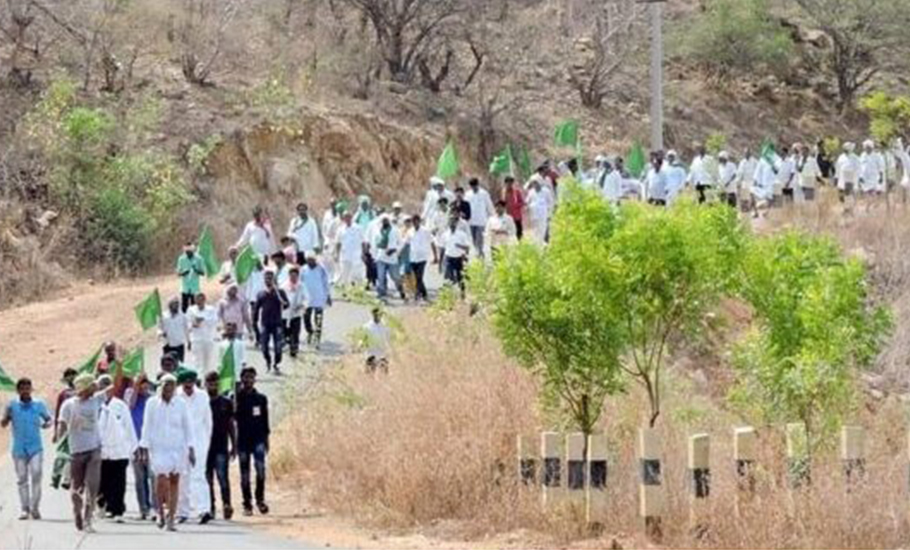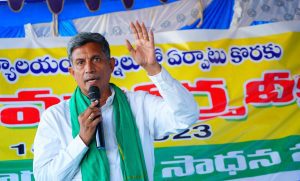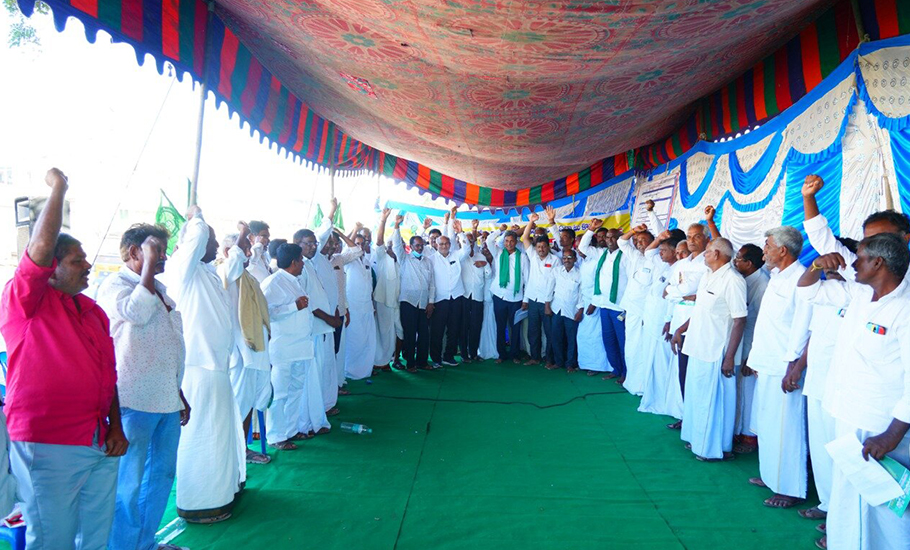
A vigorous farmers’ movement grips Andhra's Rayalaseema

About 1,000 farmers assembled on an unpaved road leading to the Regional Agricultural Research Station (RARS) which houses the temporary office of the Collectorate of the newly carved Nandyal district in Andhra Pradesh.
There was no hype normally associated with political meetings. The area was devoid of the excitement seen before the arrival of a VIP. The road did not choke with luxury cars and police.
No breakfast was served. No tea was offered. Farmers reached the venue on their own, mostly by buses. Except drinking water, nothing was served. The meeting began at 9.30 am and ended by 4.30 pm.
Also read: Visakhapatnam to be new Andhra Pradesh capital: Jagan
Nobody left during the meeting, organised under the shade of a tent. The slogan, Separate Rayalaseema State Zindabad, was conspicuously missing. Barring former MLA Varadarajulu Reddy, no politician was among the farmers.
At the end, a resolution demanding the Andhra Pradesh government to set up a Krishna River Management Board (KRMB) office at Kurnool was adopted. This happened on January 18.
Krishna water
The KRMB was set up by the Centre to resolve the water disputes that arise between Telangana and Andhra Pradesh, with its office in Andhra. Since the Srisailam project that facilitates the sharing of Krishna water between the two states falls in the region, farmers of Rayalseema want the office of KRMB should be located at Kurnool.
So, farmers think Kurnool is the ideal place for the KRMB while Chief Minister YS Jaganmohan Reddy wants it in Vizag, his yet-to-be realised dream capital of the state.
Also read: 2024 Andhra polls: Why Jagan’s populism may not work in his party’s favour
Opposing the government move, angry farmers from all Rayalaseema districts – Kurnool, Kadapa, Anandhrapuram and Chittoor – staged a day-long protest under the aegis of the Rayalaseema Saaguneeti Sadhana Samiti (RSSS) in Nandyal.
How do you appoint a referee in one place when the match is played at another, asked RSSS President Bojja Dasaratha Ramireddy.

“All the systems that carry water to four erstwhile Rayalaseema districts are dependent on the Srisailam project. Though the region is entitled to get water to irrigate 19 lakh acres, in practice water is available for only 8 lakh acres,” said Ramireddy, a management executive-turned-activist who launched the RSSS as a non-political farmers body 12 years ago in 2011.
“KRMB is responsible for water management, dispute resolution, monitoring of water usage. The region’s farmers have been fighting for their water rights for decades. It’s only fair to set up the KRMB office closer to the farmers than in faraway Vizag,” he added.
RSSS takes birth
Instead of succumbing to slogans like Separate Rayalaseema, the RSSS has become the first movement that has made welfare of the farmers, not votes, its core programme.
Also read: 2024 AP polls: Naidu’s ‘last chance’ slogan vs Jagan’s ‘one more chance’
Rayalaseema is turning into a fertile ground for a new non-political agitation by farmers over a variety of grievances: denial of capital at Kurnool, diverting the proposed central institutes to Amaravati region, a judicial capital at Kurnool becoming a non-starter, attempts to kill the 120-year-old agriculture research station at Nandyal by taking away its land to build a medical college as well as inadequate allocation of funds for irrigation projects in the region.
Andhra Pradesh has not seen an independent farmers’ movement a la Sharad Joshi’s Shetkari Sanghatana (Maharashtra), Prof M D Nanjundaswamy’s Karnataka Rajya Rythu Sangha (Karnataka), Mahender Singh Tikait’s Bharatiya Kisan Union (North India).

In the earlier days, Communists and farmer leaders such as Prof NG Ranga tried to organize peasants. While communist parties failed to mobilise farmers consistently, Prof Ranga ended up in the Congress party.
The late Prof Ranga’s followers such as Dr Yalamanchili Sivaji and Vadde Shobhanadriswar Rao basically became spokespersons of farmers of coastal Andhra. Rayalaseema region was ignored by the Communists and coastal Andhra’s farmer leaders.
Desolate farmers
Consequently, the region’s farmers were left to the whims and fancies of political leaders who exploited them whenever out of power. They brandished the ‘separate Rayalaseema state’ threat periodically but this was ignored by both farmers and general public.
Noted rights activist A Chandrasekhar feels that the emergence of regional parties like the Telugu Desam Party and YSRC sounded the death knell to the peasant’s movements as they projected themselves as pro-farmers.
“The communist movement revolved around the ‘land to tiller’ concept which was opposed by rich peasants. Many rich peasants allied with regional parties. So, the state has never had an independent movement,” he said.
The main casualty of this is the Rayalaseema region which has produced more chief ministers (Chandrababu Naidu and YS Jaganmohan Reddy) than farmer leaders. Curiously, they shy away from uttering the word Rayalaseema. Using the collective name of the four districts lends legitimacy to the regional identity which might help give a political form to the discontent in future. So, an independent farmer’s movement has not been allowed in the region.
The arrival of RSSS is a new beginning.
Ramireddy
Ramireddy quit his job in 2010s to work on farmers issues. After dabbling in the Federation of Farmers Associations for a while, he turned his attention to a welfare trust he began in the memory of his father Bojja Venkata Reddy.
But he soon realised that as long as the region doesn’t get assured water, farmers’ welfare is not possible. This led to the formation of the RSSS, which stands for the Association to Achieve Irrigation in Rayalaseema.
“I found the policies of TDP and YSRC as antithetical to Rayalaseema. While TDP revolved its politics around Amaravati, Jagan was bogged down by the proposal of shifting the capital to Vizag. Backward Rayalaseema doesn’t figure in their scheme of things. As there is no independent farmers’ movement, these parties have cleverly manipulated Rayalaseema people and farmers to support their capital politics and pro-coastal Andhra projects,” Ramireddy told The Federal.
Narrating how the Andhra government is pursuing anti-Rayalaseema policies, Ramireddy said the government had planned to build a medical college on the lands of the agricultural research station at Nandyal.
“The research station was set up in 1906 with a mandate to improve the cotton and sorghum varieties to suit the scarce rainfall zone. A medical college can be set up anywhere outside the town, not on the fertile lands dedicated for research. We had to challenge the decision in the High Court which stayed the alienation of these lands for medical college,” he said.
The RSSS is becoming a defiant voice of Rayalaseema.
Protests galore
On May 31, 2016, about 25,000 farmers led by RSSS had laid the foundation for a weir at the Siddeswaram to store 50TMC of water that could be diverted to Rayalaseema.
Since there was no response from the government on their demand, the farmers walked nearly 100 km from Nandyal to reach Siddeswaram in Srisailam project backwaters and, in an act of defiance, laid a symbolic foundation stone for the project.
The RSSS is pursuing a novel model of decentralized agitations to spread awareness across the region.
“Instead of setting up RSSS branches in other districts, we ask the locals to agitate under their own banner. The RSSS will extend all support. We encourage people to uphold their own banner and identity and build a network of organizations. Our strategy is to inculcate the habit of questioning the governments on the all-round injustice done to the region,” he said.
“Individually, the leaders of TDP and YSR Congress endorse our demands. But they don’t want to participate in the movement. All independent writers, intellectuals and other farmer organizations are joining us as we have no electoral agenda. Our fight is to divert the Krishna waters flowing into the sea to the arid zones of Rayalaseema,” said Yerva Ramachandra Reddy, Vice President of RSSS.
Discredited politicians
Attempts to harness river Krishna for the benefit of the region began only in 1983 when TDP founder NT Rama Rao was the chief minister. But many of the systems NTR envisioned are still complete.
The next major push came from Congress chief minister YS Rajasekhar Reddy when he launched a scheme called ‘Jalayagnam’ in 2004. His sudden death in 2009 and the Telangana movement put paid to Rayalaseema’s water dreams.
The RSSS argues that neither Chandrababu Naidu’s TDP government nor YS Jaganmohan Reddy’s present dispensation has the will to complete the incomplete projects by allocating the enough funds.
“Ruling parties are more interested in returning to power in the next election. They don’t want to antagonize the rich Delta farmers of coastal Andhra who draw more water from Krishna and Godavari through the irrigation systems built in British and independent India. The chief ministers fear that taking up Rayalaseema cause could prompt backlash from the coastal region which has more seats in Assembly,” Ramireddy said. It is in this backdrop that the RSSS took birth in 2011.
The name Rayalaseema (region ruled by Krishnadevaraya of Vijayanagara empire) was given to the region ceded to British East India Company in 1800 by the Nizam as part of a subsidiary alliance. The districts loosely went by name ceded district. But in August 1928 the name was changed to Rayalaseema in a conference organized in Nandyal.
Rayalaseema
Since the region is culturally distinct from the rest of Andhra, in the course of time the term has acquired the contours strong sub-regional political identity. Whenever there was threat to their survival, politicians of the region exploited the identity, sometimes even demanding a separate Rayalaseema state.
Now, for the first time, the region is witnessing a credible movement led by a farmer which has the potential to become an umbrella for broader sub-regional movement in Andhra Pradesh.


